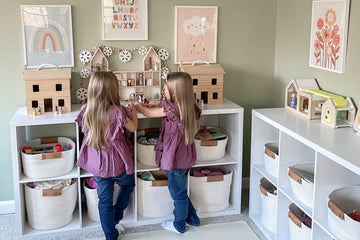When you watch children play, their behaviours may seem random - stacking blocks, spinning objects, or repeatedly throwing toys. However, there is a fascinating structure behind these actions called play schemas. These repeated patterns of play are crucial to children’s learning and development, helping them explore the world around them in meaningful ways.
What Are Play Schemas?
Play schemas are recurring behaviours or actions that children engage in during play as they try to understand how things work. These patterns help children make sense of concepts like movement, positioning, balance, and connection. Play schemas are instinctual and vary from child to child, evolving as they grow.
For example, a child might repeatedly knock down towers of blocks, fascinated by the way they fall. This is an expression of the trajectory schema, where the child is exploring movement, force, and gravity. Another child might enjoy arranging toys in a line, which reflects the positioning schema, a behaviour centred around organizing and ordering objects.
Common Play Schemas
Here are some of the most common play schemas that children exhibit:
Trajectory Schema: Children are fascinated by movement and may engage in activities like throwing, dropping, pushing, or rolling objects. They may also explore movement with their own bodies by running, jumping, or climbing.
Rotation Schema: This schema involves a child’s fascination with spinning objects, rotating themselves, or turning things around. Children may love spinning wheels, watching tops twirl, or even turning in circles themselves.
Enclosure/Enveloping Schema: In this schema, children enjoy enclosing objects or wrapping things up. They might build fences or barriers with blocks, hide toys under blankets, or cover objects with materials.
Transporting Schema: Children love to carry objects from one place to another. They may fill bags or containers with toys and move them around, or transport things in their hands or pockets.
Positioning Schema: This schema involves organizing or arranging objects in a specific order or pattern. Children may line up cars, sort items by colour, or carefully stack blocks in a particular way.
Connecting Schema: Children in this schema are interested in linking objects together, such as building with blocks, connecting train tracks, or tying things together.
Transforming Schema: This schema involves exploring changes in objects or substances. Children might enjoy activities like mixing water and sand, painting, or playing with dough, transforming materials in creative ways.
Orientation Schema: Children may enjoy viewing objects or their environment from different angles or perspectives. They may turn objects upside down or tilt their heads to see things from a new viewpoint.
Containing Schema: Children are drawn to placing objects inside containers and then removing them again. This might involve filling and emptying cups, boxes, or baskets.
Why Play Schemas Matter
Play schemas are critical because they help children build fundamental cognitive, motor, and emotional skills. Each schema allows children to investigate and understand specific aspects of their world. For example, a child experimenting with the trajectory schema learns about motion, cause and effect, and spatial awareness. Another child engaged in the rotation schema may develop coordination and balance as they spin and rotate objects.
These schemas not only help children develop important skills but also provide insight into their interests and developmental stages. By recognizing your child's play schema, you can choose toys and activities that support their natural way of learning.
How Toys Support Play Schemas
Educational toys play a significant role in supporting and enhancing play schemas. By offering toys that align with a child's schema, you encourage them to explore and learn in ways that feel intuitive and enjoyable.
For instance, toys like rolling drums or balls support the trajectory schema, encouraging children to explore movement and force. Stacking toys and puzzles align with the positioning schema, helping children practice organization and problem-solving skills. Toys like spinning tops or activity centres with wheels support the rotation schema, offering opportunities to explore circular motion.
Examples of Toys for Play Schemas
Here are some great examples of toys that encourage different play schemas:
- Rotation Schema: Rolling Drum Wooden Toy – This rolling drum encourages children to explore spinning and circular motion. The drum's bright colours and rotating features captivate children's attention, promoting motor skill development and curiosity about movement. Whether pushing or spinning it, this toy provides endless opportunities for kids to explore rotation and motion.
- Positioning Schema: Wooden Animal Stacking Toy – These stacking toys allow children to arrange and balance animals, helping them develop spatial awareness and fine motor skills.
- Transporting Schema: Children's Busy Board Walker – Perfect for children who love to transport objects, this multifunctional walker provides storage space for toys that can be loaded and carried around. Children can explore moving objects from one place to another while practicing their gross motor skills, balance, and coordination as they push the walker around.
- Trajectory Schema: Wooden Knock Box – This knock ball toy lets children explore cause and effect by hammering balls and watching them roll.
- Enclosure/Enveloping Schema: Wooden Puzzle Toy Blocks – Ideal for children engaging in this schema, this puzzle toy allows them to explore placing objects within specific spaces. The perforated design and different block shapes encourage children to fit the pieces into their matching slots, helping them understand containment, spatial awareness, and problem-solving. This hands-on exploration fosters cognitive development while satisfying their natural urge to enclose or envelop objects.
How to Support Your Child’s Play Schemas
Understanding your child's play schemas can help you create an enriching play environment. Provide them with toys that align with their schemas and encourage open-ended play. Allow them to repeat their actions, as repetition is a key part of how children learn. Most importantly, follow their lead—observe what interests them and support their natural curiosity.
By offering toys and activities that match their play schema, you are enhancing their learning and helping them develop essential skills in a way that feels natural and enjoyable.
Play schemas are an incredible way for children to learn about their world. Recognizing these patterns and supporting them with the right toys can help children develop key skills, from coordination to problem-solving. Explore a range of educational toys that align with different play schemas at Cabe's Playhouse, and support your child's development through meaningful, playful learning.






